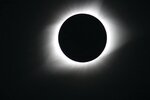

I am only a casual observer of the skies most of the time, but I’ve always been right out there in the dark when celestial events were predicted. Even to the point of climbing rickety steps to a skyscraper roof in Manhattan when I lived in the city.
While Monday’s total solar eclipse has been called “nature’s most spectacular event,” I am disappointed we will see only a wimpy version of it here in Bucks County.
While we live beyond the realm of totality (total darkness), I’m more than happy my daughter will witness the true magic in San Antonio.
When it comes to scanning the heavens, our little family has truly been blessed to live in Durham which, I’ve been told, is the darkest spot on the East Coast. When the weather is clear the night sky offers a feast for the eyes.
So much so that when our children were little we frequently woke and bundled them up, if it was cold, and took them out into the night to look at shooting stars or comets. My parents had done the same when I was a child.
It would, we hoped, create for them a sense of wonder, a special acknowledgment of the natural world and the tiny place we occupy in it. It seems to have worked. When he was about 9, our son asked for a telescope — and he used it.
And now, our daughter has already made plans to witness the eclipse. San Antonio is one of the first cities to see the moon totally block out the light of the sun for up to 4 minutes and 28 seconds as it sweeps eastward from Mexico across the country to New England before heading to Canada’s maritime provinces.
It’ll be the first time a section of San Antonio is inside the path of totality — where the moon’s shadow completely obscures the sun — in more than 600 years.
The National Aeronautics and Space Administration (NASA) estimates it will take 400 to 1,000 years before totality returns to the same spot.
Our daughter and her co-workers are planning to drive to a place about 10 miles from their office to view the eclipse at a more advantageous point. It will provide a longer period of total darkness — when birds sing their night songs in the middle of the day and then go silent — and a genuinely more memorable experience.
Our special Texan (transplant, though she is) also saw last autumn’s annular eclipse that left a “ring of fire’’ visible around the edge of the moon as it covered the sun.
“It was cool,” she told us. “You could actually feel the temperature drop about 10 degrees. It was so dark and the birds stopped singing. It was interesting to watch the sky darken before the eclipse and then lighten after, she said.
She sent us photos showing the ring of fire.
That event was just a preview for next week’s sky show. The moon’s disk was not big enough to cover the entire sun and the sun’s outer edges could still be seen, according to NASA.
In next week’s heavenly show, the moon will completely cover the sun. This can only happen when the moon is nearest the point of orbit closest to Earth. You can only see a total solar eclipse and its corona if you’re in the path where the moon casts its darkest shadow.
The last time the greater Philadelphia area was in the direct line of total solar eclipse was in 1806. So it’s pretty clear we won’t be seeing Monday’s. We’ll just have to settle for a wimpy darkening of the sky.
Kathryn Finegan Clark is a freelance writer who lives in Durham Township. She can be reached at kathyclark817@gmail.com.
Join our readers whose generous donations are making it possible for you to read our news coverage. Help keep local journalism alive and our community strong. Donate today.